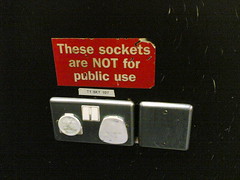Posted: January 18th, 2007 | No Comments »
Hazas, M., Scott, J., and Krumm, J. Location-aware computing comes of age. IEEE Computer 37, 2 (2004), 95–97.
This introductory paper to Location-Aware Computing talks about the numerous location-sensing systems that differ with respect to accuracy, coverage, frequency of location update, and cost of installation and maintenance. The authors devid them into coarse-grained and fine-grained systems.

Many similarities with A Survey and Taxonomy of Location Systems for Ubiquitous Computing.
Relation to my thesis: Which coarse-grained and fine-grained location-sensing systems ought to be used to match the location information granularity expected by a user on a specific activity. I am interested in granularity not only based on accuracy, but also in terms of timeliness.
Posted: January 18th, 2007 | 3 Comments »
Bell, G. and Dourish, P. In press. Yesterday’s Tomorrows: Notes on Ubiquitous Computing’s Dominant Vision. Personal and Ubiquitous Computing.
In this article, the authors advocate for developing a “ubiquitous of the present” which takes the messiness of everyday life as a central theme. The argumentation is organized around three framing points: ubicomp is already here, but does not have the form we envisioned, the futurist vision of ubicomp allows researchers for responsibilities for the present, and ubicomp is inherently messy.
Ubicomp is present
Ubicomp is essentially defined by its vision of a technological future. The literature carries the idea the ubicomp research is exploring prototypes of tomorrow’s everyday technology and everyday experience is a pervasive one. However, when we look outside of the research laboratory (based on 2 case studies in Korea and Singapore in this paper), the author look at ubiquitous computing. They argue that ubicomp is already here; it simply has not taken the form that we originally envisaged and continue to conjure in our visions of tomorrow.
The vision as excuse
The framing of ubicomp as something yet to be achieved allows researchers and technologies to absolve themselves for responsibilities for the present; the problems of ubiquitous computing are framed as implementation issues that are, essentially, someone else’s problem, to be cleaned up afterwards as part of the broad march of technology.
Ubicomp is messy, seamlessnes is a misleading vision
The seamlessly interconnected world of future scenarios is at best a misleading vision and at worst a downright dangerous one. [...] Dealing with the messiness of everyday life should be a central element of ubicomp’s research agenda. In practice, though, we see that infrastructures are continually visible and must be consciously attended to in the course of everyday encounters with ubiquitous computing, from the vagaries of network access to the structure of service billing. [...] Infrastructures remain messy after decades or centuries, as the user of any transit system from urban subways to international airlines can attest. [...] The crux of her approach is to look at infrastructure as a relational concept; an infrastructure is an infrastructure only from the perspective of specific peoples and technologies. [...] In other words, infrastructures are messy. The messiness that we experience in laboratory ubiquitous computing infrastructures is not a property of prototype technologies, of the bleeding edge, or of pragmatic compromise; messiness is a property of infrastructure itself. Infrastructures are inherently messy; uneven in their operation and their availability. [...] Mobile telephony, after all, offers widespread coverage, but is neither truly ubiquitous nor truly seamless; incompatible standards, spotty regional coverage, etc., seem like obstacles that we must still overcome before the ubiquitous computing vision can be realized. But postulating a seamless infrastructure is a strategy whereby the messy present can be ignored, although infrastructure is always unevenly distributed, always messy. An indefinitely postponed ubicomp future is one that need never take account of this complexity. [...] Infrastructures, then, be they networks of car mechanics, medical categories, or power sources, are never seamless in the ways in which they are put to work. They are sites of negotiation and contest, compromise and coordination, approximation and partial agreement. They are unevenly distributed and unevenly available. They are continually in flux, and brought into local stability only through active engagement and coordination. Infrastructure itself is a relational property; it describes a relationship between technology, people, and practice. [...] It is not merely a dream of a world not yet realized; it is a dream of a world that could never be realized.
Relation to my thesis: The observation of ubicomp as inherently messy is at the core and a trigger of my research. Ubicomp literature mainly contain studies and prototypes embracing the seamless utopia. I wrote my paper Getting real with ubiquitous computing: the impact of discrepancies on collaboration partially in reaction to the “perfect-world” expectations around ubicomp. Weiser’s humanist vision did not fit at all my observations during the CatchBob! experiments. Bell and Dourish they take a very similar perspective as Adam Greenfield in Everyware claiming that ubicomp is here. This is probably something that was missing in my paper. I failed to notice the arrival of ubiquitous computing is rooted (at least in part) because it has been so much rooted around the idea of seamless interoperation and homogeneity.
Posted: January 18th, 2007 | 1 Comment »
Based on their first experiment to Visualizing the Crowd’s “Mental Map” Using Flickr Geotagged Images, Yahoo! Research Berkeley has now introduced their TagMaps toolkit with a sample applications (World Explorer, Night Explorer and Trip Explorer). The size of the tags reflects their importance. The bigger the tag, the more “important” for location and the given zoom level, tag frequency, uniqueness, user identity and social factor.

World explorer in Barcelona
Relation to my thesis: An example to reveal user-generated location information. The Night Explorer takes into consideration the timeliness of the location information.
Posted: January 18th, 2007 | 1 Comment »
Jan Chipchase has post on a remote control to operate the toilet with peace-of-mind-security coverage placed next to the toilet interface. So when house guests are wanting to flush and aren’t familiar with these interfaces it is no surpise that the ‘wrong’ button is pressed and an alarm sounds, and the security company sends out a uniformed emergency response team. There is of course many wrong approaches in this future-perfect-connected world situation. Yet, it reminded me of the thoughts of Adam Greenfield on the the blue toilet of death highlighting the coexistence of systems surrounding us and their nonlinear interactions and the affective dimensions of system failure (advocating for “graceful degradation”).
And still nobody was talking about the nonlinear interactions of network systems in one space all operating at once – it’s as if none of the people who were designing them had, not so much thought, but felt what it would be like to sit in the middle of a room where you’ve got fifteen different technical interfaces around you, and you’re responding to all of them at once, and they’re all responding to you at once.
[...]
But I’m not sure how many people in academic ubicomp have really marinated themselves in a consideration of the experiential and affective dimensions of system failure. I’m not sure to what degree people have ever simply sat and imagined what it will feel like when systems like these surround us…and break down, as technical systems often do. They may have thought about the specific system at hand, but as a gestalt? I haven’t heard that many people raising the issue.
These kind of problems are exemplified by Fabio Sergio and his story with motion sensors in a bathroom and considerations on reactive system as well as by Mark Meagher on automatic doors and how the funtionality of the door are invisible and no attempts are made to communicate to the user.
I enjoy observing people (and myself) waving my hands in front of a tap or to an automatic doors. Doors in swiss train are particularly prone to the situations described by Mark. Their opening is often slow, maybe due to the overuse of the sensors or most probably to their bad calibration. Some train have sensor on the floor (opening when you step in). It is not unusual to see people jumping or hardly stepping in front of the doors. Other trains have their sensors in the top and bottom of the door. I noticed that even some train directors do it and some people refusing the automation and manually forcing the door to open. I am wondering if there is ever been a study a user-centered study to calibrate the swiss train automatic doors to lower the user confusion.

Geberit’s eyes, motion sensor in a bathroom
Relation to my thesis: My work highlights to problem of integrating technological limitations (such as system not being able to coexists) and human factors in real-world environments. I already mentioned it in Peaceful Cohabitation and Scalability in Ubicomp. I am exploring how to support user activities top of errors and system-generated uncertainty. In the context of interaction, I guess it is not only important for interfaces to reveal their functionalities and states, but also to think in terms of granularity (for example to calibrate thee automatic doors) as express by Mike Kuniavsky.
Posted: January 17th, 2007 | No Comments »
Ed Parsons posted a short report of the couple of days he spent at Reuters, as part of their excellent Innovation Programme. He mentions the increasing interest for Reuters to deliver location and consumer focused information but as with many things maybe it will take at least three or four attempts for location based services to reach the mainstream. The challenges to deliver appropriate LBS (e.g. data availability, privacy concerns, standards). However, Reuter’s interest show the intention to innovate in the long term in this space.
Relation to my thesis: In the past, location information where given by official or central entities. The bottom up generation of geolocated information raises not only the problem of lack of standards but also on the granularity (or generalization) and the subjectivity of the location attached to the information. Similar challenges faced by GeoCommons for example, that companies such as Urban Mapping try to tackle.
Posted: January 16th, 2007 | 1 Comment »
Since I last used GeoIQ to create my heatmaps on the usage of the accuracy feature in the Flickr geottaged images, Fortiusone has been busy developing an moving from Google Maps to KML as well as setting up a repository for shareable geospatial called GeoCommons. Besides uploading and downloading data from GeoCommons, users will be able to take their data and anyone else’s in GeoCommons and make a mashup with GeoIQ heat map generator. FortiusOne founder Sean Gorman provides a compelling proof of concept in the company’s blog with a mashup of highly rated bars and single women in Manhattan.

Relation to my thesis: GeoIQ has been a great tool to quickly get heatmap viz of some of my geodata. Their GeoCommons might be an excellent opportunity to explore more the levels of granularity used when people share geodata. In the context of GeoCommons, I am also interested to observe how the accuracy and veracity of the data is handled. It is I guess one of the challenge of such a collaborative platform.
Posted: January 10th, 2007 | No Comments »
I took the opportunity of the upcoming LIFT open stage session to propose a talk on technology and messiness, a subject related to a philosophical aspect in my research that highlights the mismatches between our needs, expectations and behaviors towards technologies.
Embracing the real world’s messiness
Description: Science and engineering aim at improve and facilitate our lives. However, multiple physical, economical, organization and social constraints challenge technologies to seamlessly provide well understood services. Unlike often advertised technologies do not lead us to live in harmony with quiescent and stable systems. Indeed, to live in our everyday world, systems must always be maintained, and our relationships to them must be continually negotiated. The increasing complex integration of technologies in our digital lives and cities further highlights new types noises, failures and annoyances, as the user of any international airport or mobile wireless service can attest. This talk will raise these issues by exemplifying the messiness inherent to technologies.
Update: Presentation of the talk proposal on the LIFT07 blog.


The messiness around us… (the nests of cabling barely hidden in the dropped ceiling)
Posted: January 10th, 2007 | No Comments »


Posted: January 5th, 2007 | 1 Comment »
Anthony Steed now provides an online demonstration video of his experimental piece of software for investigating GPS satellite availability. This work on GPS satellite visualization was part of his Mobile HCI 2004 paper on Supporting Mobile Applications with Real-Time Visualisation of GPS Availability

Relation to my thesis: An example to reveal the seams of a positioning system.










